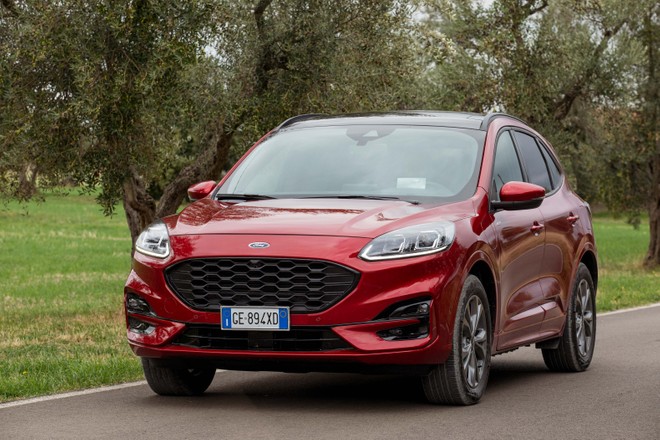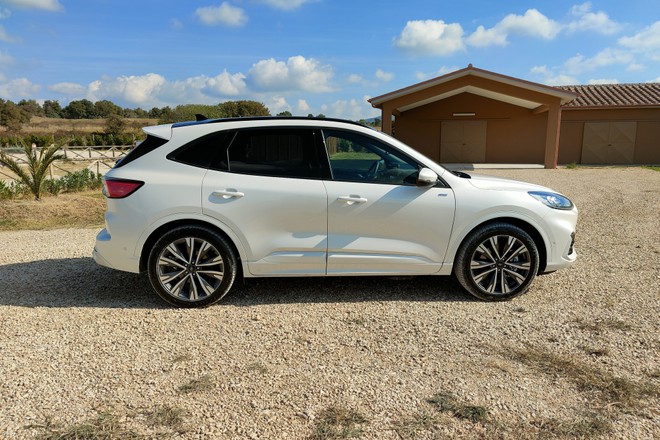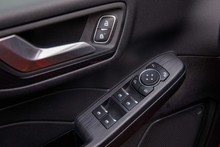Ford Kuga & egrave; a compact SUV of segment C very versatile in offering potential customers many choices for engines: the most; sophisticated & egrave; the 225 bhp Plug-In hybrid version but there are also the hybrid version (Full Hybrid, 190 bhp), the petrol mild-hybrid (150 bhp) and, now a rarity, the one with a 120 bhp diesel engine.
Overcoming the problems of youth which caused a stop to sales in 2020, the Kuga on tap returns to the attack of the market. Here's how & egrave; the first road test went and what are its strengths and weaknesses.
KUGA HYBRID PLUG-IN 

With a 14.4 kWh gross battery, 10.3 kWh net , Ford Kuga PHEV allows you to travel in mode electric with zero local emissions up to 130 km/h and & egrave; able to propose a good autonomy. If we exclude the motorway, in fact, the electric autonomy of Kuga Plug-In can be; reach 40 and 50 km (65 declared in WLTP), and the system & egrave; of new generation because & eacute; can & ograve; take advantage of a liquid-cooled battery pack with a warranty of 8 years or 160,000 km.
The slow recharge , with the 1.8 kW home charger supplied as standard , takes place in 6 hours since it stops at a maximum of 8A . Alternatively, by purchasing a Type 2 cable and using a wallbox or column, you can go down to about 3 hours being able to charge maximum to 3.6 kW .


Kuga Plug-In lags behind some PHEV competitors in charging power, but compensates with the app thanks to FordPass Connect as standard : the charging status can be controlled remotely via the smartphone which also allows access to many other information about the car, notifications included.
When the battery runs out , Ford Kuga Plug-In Hybrid behaves exactly like a & # 39; hybrid : the system & egrave; the Toyota one we saw recently on the Lexus NX and which, on the Kuga Full Hybrid, uses a 1.1 kWh battery.
With zero electric km on the instrumentation, which does not correspond to a completely discharged battery, the American SUV works in mode; hybrid by exploiting the capacity; residual (and invisible) battery and manages to obtain consumption between 5.5 and 6.5 liters per 100 km between cities. and extra-urban.
Driving , Kuga PHEV points out its increased mass: 1,844 kilograms. The inertia is perceived in the very rapid changes of direction and this leads to controls that are more & ugrave; invasive when you go to force the car into a narrow and dynamic path in terms of curves. The calibration & egrave; made precisely to anticipate the inertia that would risk triggering the loss of control if not managed well on low-grip funds or at high speeds. It must be said for & ograve; that, testing it with the controls deactivated, the car has a fairly manageable chassis, a sign that Ford could let the reins a bit more dissolved by implementing a more & ugrave; progressive electronics.
Despite the mass, Kuga & egrave; capable of good consumption in mode & agrave; hybrid, but the effect of the eCTV is perceived in an important way inside the passenger compartment during intense acceleration. On the other hand, in the city guide will be & agrave; difficult to notice because & eacute; the system works much more; in electric and sar & agrave; that engine to provide the necessary cue using the battery.
One steering less sharp than what is usually proposed by Ford, even on compact SUVs such as the excellent Puma, it seems to want to communicate that Kuga should be driven more in a way; quiet: & egrave; made to travel in comfort, good that of suspensions and seats, even if the soundproofing at 130 km/h suffers from the aerodynamic rustles that come from the most part; high of the car.
TECHNOLOGY, COMFORT AND EQUIPMENT 
, USB sockets (including USB C), dual-zone automatic climate control and the many tricks for those who sit in the back. </p>
<p> <img src = )

Passengers can tilt the backrest and move the rear seat forward or back to gain comfort or space in the boot. Present the air conditioning vents, USB and heated seats also for those behind.
The infotainment SYNC 3 & egrave; complete in the functions but sports hardware and graphics that do not hold up the comparison with SYNC 4 … must & agrave; wait for a restyling to see it.
THE PLUG-IN … WELL USED 
 or less of 2 & euro; for those 40/50 km: with petrol at 1.7 & euro;/liter, the thermal version requires at least 4 & euro; to travel 50 km with a very light foot. </p>
<p> PRICES AND PROMOTIONS <img src = )

The most powerful plug-in hybrid Kuga; economic & egrave; the Connect which costs 38,550 & euro; from the price list and € 33,250; in promotion . Less eye-catching than the ST-Line, which sports a certainly more grille and bumper; aggressive, Connect & egrave; a good entry point because it has standard alloy wheels (only 17 & quot; per & ograve;), fog lights, LED lights (daytime and rear), matching mirrors (heated and electrically adjustable), the now unobtainable double true exhaust terminal, automatic lights , dual zone climate, keyless, leather steering wheel and gearbox, cruise control, limiter, display from 8 & quot; and mixed instrumentation with 4.2 '' screen, FordPass Connect with 4G SIM, lane keeping and anti-collision with automatic braking (recognizes pedestrians and cyclists).
FORD KUGA PLUG-IN ONLINE CONFIGURATOR
The CoPilot package for Level 2 autonomous driving, the one that focuses the car on the vehicle & # 39 ; inside the lane and has adaptive cruise control, costs 1.000 & euro; but you can & ograve; choose only from the ST-Line . This is the recommended set-up: the alloy wheels are 18 & quot ;, the LED fog lights, the mirrors are also electrically foldable, the keyless & egrave; complete (entry and start), the wiper sensors arrive, the instrumentation & egrave; digital from 12.3 & quot; and there are also rear USBs, front and rear parking sensors, LED ambient light and specific seats. Kuga Plug-In ST Line starts at 42,250 & euro; price list, 36,750 & euro; with the promotion in progress .
VIDEO
The Samsung pi? balanced? Samsung Galaxy A52 5G, buy it at the best price from Amazon at 409 euros .